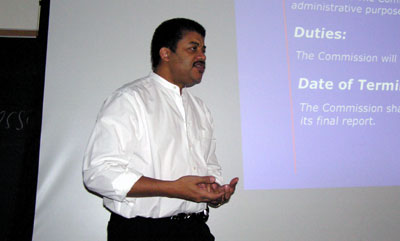A look inside the Aldridge Commissionby Jeff Foust
|
| “The vision is a given. The vision was actually extensively vetted and so that is not our charge. Our charge is to find ways a consensus can be shaped around the vision, and then explore strategies to implement it.” |
Tyson did reveal, though, that he also played a role in shaping the vision itself before it was publicly announced and before the commission was created. “I’m particularly connected to that space vision because I worked with the head of NASA for his presentation to the President that led to this space vision,” he said, although he did not elaborate on the nature of his input.
He did note that the commission does not feel that restricted because it has a fairly wide latitude in proposing recommendations. He noted that, for example, the commission could recommend that NASA undertake a human mission to an asteroid after returning to the Moon but before going on to Mars. “Asteroids are not explicitly mentioned in the vision, so that would be an adjustment to it while still maintaining the total scope of the vision,” he said.
The implementation recommendations the committee does make will be at a fairly high level. “We’re not going to say, cancel this mission, add that mission,” he said. “We might say that you’re not spending enough on propulsion, but we’re not going to say to use this propulsion over that.”
Those recommendations will be aligned among four general themes: competitiveness and prosperity, science and technology, management and sustainability, and education and youth. Under those themes the implementation recommendations will cover a broad range of topics, from systems engineering to enabling technology to international cooperation.
Sustainability and bipartisanship
One major issue that the new space initiative faces is sustainability: how do you maintain a long-range program like the President’s plan, with milestones that extend to 2020 and beyond, given the changes in both administrations and Congresses? The commission identified sustainability as perhaps the biggest challenge facing the plan during its first public hearing, and Tyson spent some time during his presentation to address the issue from a couple of different angles.
| “My nightmare is that we have a next President who does not want any part of this vision, but still allows the space shuttle to cancel itself out, does not top off the budget, and everything washes down the drain.” |
Tyson argued that the plan was realistic because it did not require increasing NASA’s budget any faster than the rate of inflation over the long term. He noted that while NASA’s annual budget peaked in the mid-1960s at about $25 billion in current-year dollars (compared to about $15 billion today), if you take a ten-year running average of the budget, the values change very little. “For any ten-year period you draw here, NASA’s budget has been about the same,” he claimed. “So it is not an argument to say that we will not be able to raise as much money as we did for Apollo. We already have that much money.”
To further illustrate his point, Tyson displayed the famous “layer cake” chart that shows the proposed budgets for major NASA programs through 2020, illustrating how the wedge for the exploration program grows as other programs, notably the space shuttle and space station, are phased out. He admitted, though, that there is a risk that as the shuttle and station programs end, those funds might get moved out of NASA entirely. “My nightmare is that we have a next President who does not want any part of this vision,” he said, “but still allows the space shuttle to cancel itself out, does not top off the budget, and everything washes down the drain.” He said that the commission is “sensitive” to such a possibility, and will try to offer strategies to minimize that possibility.
One of Tyson’s concerns related to this possibility is that the new initiative might become entangled in partisan politics. Already the new initiative has been closely linked to Bush, and thus has come under criticism of Democrats, particularly those running for President. “I’m surprised they would reach out and make that a political issue, especially since space exploration in America has historically been bipartisan,” he said. “The last thing we want out of this mission is for it to become a partisan issue. The moment space exploration becomes partisan, just give up, go home, because space initiatives have longer baselines than political cycles. They can only survive if they’re not partisan.”
Tyson noted that the commission has made some efforts to reach out to Democrats, in particular Senator John Kerry, the presumptive Democratic nominee for President. He revealed that the commission considered asking him to testify at a public hearing, but backed away out of concerns that the other remaining candidates would demand equal time. “We do know that in the end, knowing that this is put forth by a Republican President, at some point we’re going to have to woo Democratic support,” he said. He said that the commission is considering inviting some unnamed “powerful Democrats” to speak at the commission’s final public hearing in New York in early May.
